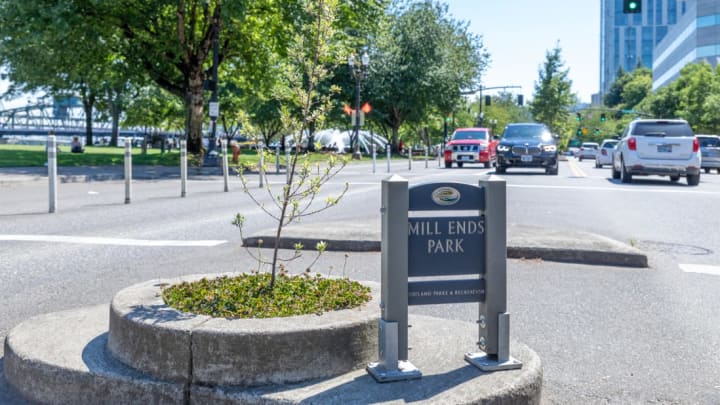“Ireland” may be the first answer that comes to mind when asked where in the world you might be most likely to spot a leprechaun, but Portland, Oregon, is home to its very own population of tiny, pot-o’-gold-loving Irishmen, too. They’ve even got a dedicated area—Mill Ends Park—to prove it. Here are 11 fun facts about what has been described as “the only leprechaun colony west of Ireland.”
1. Mill Ends Park is the creation of journalist Dick Fagan.
Upon his return home from World War II in 1946, Dick Fagan went back to work as a journalist at the Oregon Journal, where his second-floor office overlooked what is now known as Naito Parkway. Amidst all the traffic and activity that took place outside his window, Fagan became fascinated with one element of his view: A tiny hole that had been placed in the median for a light pole.
2. Mill Ends Park’s light pole never materialized.
Fagan watched as weeds began to fill in the spot where the light pole was meant to be installed. But he wasn’t happy with that either, and so he planted some flowers, too.
3. Mill Ends Park was a continuing work in progress for Dick Fagan.
Making that tiny hole in the ground pretty was only the beginning of the attention Fagan began lavishing upon the space. In his Oregon Journal column, “Mill Ends”—which, like the irregular pieces of leftover lumber it was named for, shared interesting little stories— he often referenced the leprechauns who lived in the park.
4. Mill Ends Park’s head leprechaun is named Patrick O’Toole.
Fagan, conveniently, was the only person who could see Patrick O'Toole, the leader of the leprechaun community. He also apparently spoke to him: When the mayor of Portland proposed an 11 p.m. curfew on all city parks, Fagan published a response from O’Toole, who threatened a leprechaun curse upon the mayor. (The leprechauns were subsequently allowed to stay.)
5. Mill Ends Park was dedicated in 1948.
Due to Fagan’s Irish heritage, and the leprechauns who purportedly inhabited the park, Mills Ends Park became dedicated as such, quite appropriately, on March 17, 1948.
6. In 1976, Mill Ends Park became an official city park.
Twenty-eight years after its dedication, Mill Ends Park became an official city park in 1976, again on St. Patrick’s Day. Each year, various holiday-themed events take place on the site.
7. Mill Ends Park is the world’s smallest park.
Mill Ends Park measures just two square feet, which seems an adequate size for what Fagan was fond of describing as the “only leprechaun colony west of Ireland.” Guinness World Records has recognized it since 1971.
8. Despite its small size, Mill Ends Park has a number of (very tiny) first-class amenities.
The park has become something of a must-see oddity in Portland, and many residents and visitors have made their own contributions to its growth. A tiny swimming pool (with a butterfly diving board), statues, and a pint-sized Ferris wheel—which was delivered by a normal-sized crane—are just a few of its amenities.
9. Mill Ends Park had to be moved in 2006.
In order to accommodate construction on Naito Parkway in 2006, the park had to be moved temporarily. It moved back in on March 16, 2007—the day before St. Patrick’s Day—with bagpipers playing and Fagan’s wife looking on (Fagan passed away in 1969).
10. In 2011, a man was arrested for protesting at Mill Ends Park.
In December 2011, the Occupy Portland movement installed a flash mob of plastic army men and tiny signs at the park to illustrate their mission. One of the demonstrators, Cameron Scott Whitten, was arrested when he refused to leave.
11. Mill Ends Park was robbed in 2013.
A week before St. Patrick’s Day in 2013, someone stole the park’s one and only tree… only to return it one week later.
This story has been updated for 2021.
